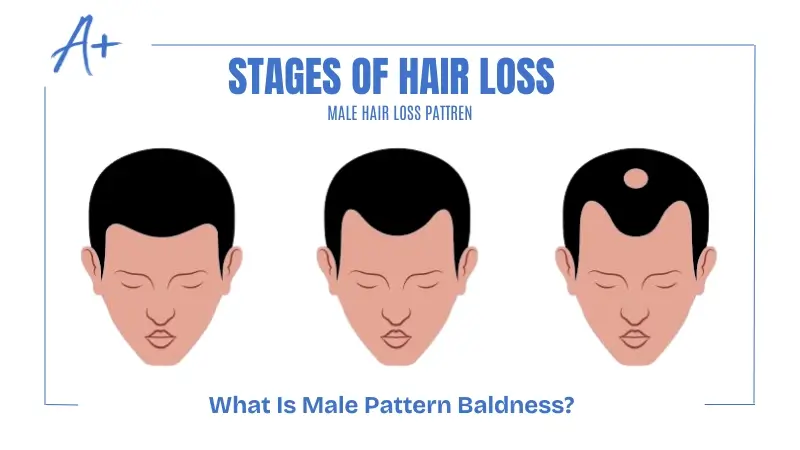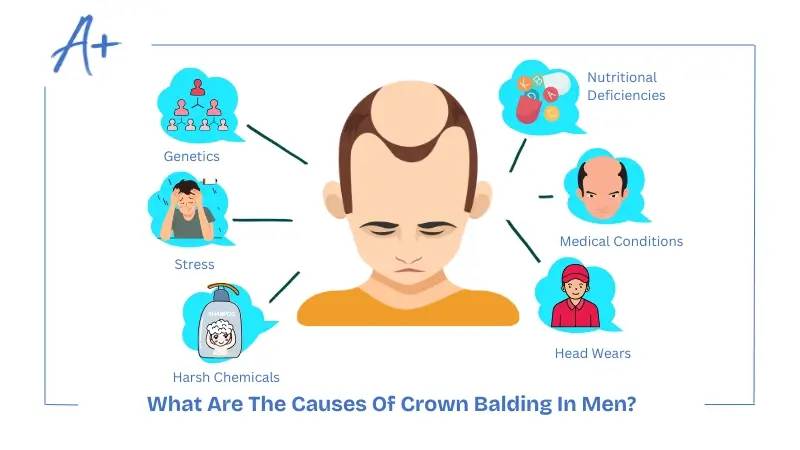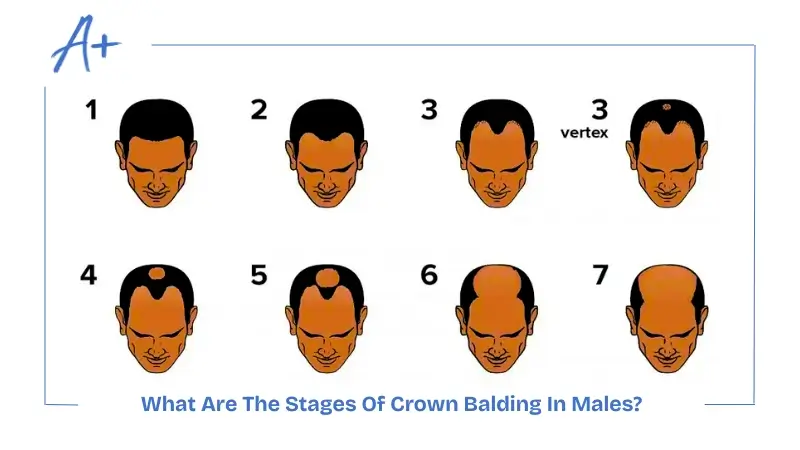Are you a man who is stressed about progressing baldness? We have come up with a detailed discussion about crown balding progression stages for you.
Balding in men has always been a subject of common concern in various age groups. Losing hair makes men distressed about their looks and lowers self-confidence. With better understanding of the crown alopecia and its progression stages, it can be diagnosed timely and managed effectively.

Androgenic alopecia or male pattern baldness is a type of hair loss specific to men. It often starts with thinning hair and increased shedding.
Moreoover, It progresses with a receding hairline, bald spots and ultimately complete hair loss on the vertex or top of the head. This often leaves hair only on the sides and back of the head or sometimes none at all.
What Are The Causes Of Crown Balding In Men?
Crown thinning in males can result from multiple reasons with genetic pass down from the parents being on the top of the list. Here are some other reasons for crown alopecia in men:

- Genetics: Balding in males is often hereditary and passed down from father to son. Genetics along with the dihydrotestosterone (DHT) causes hair follicles to weaken, shrink and hinder the new hair growth.
- Head Wears: It is very important to choose the right headwear. Tight hats, caps, hijabs, head coverings and helmets can cause hair tugging, scalp friction and hair shedding.
- Stress: Stress plays an important role in crown hair loss in men. It activates the sympathetic system, reduces the blood flow to the scalp and damages the hair follicles.
- Medical Conditions: Conditions such as alopecia areata, hypothyroidism, hyperthyroidism and SLE cause hair loss and bald spots, exacerbating male pattern baldness.
- Harsh Chemicals: Hair styling products and harsh shampoos, gels and sprays along with styling irons damages the hair follicles and cause crown baldness.
- Nutritional Deficiencies: Nutritional deficiencies such as iron deficiency, vitamin D deficiency, or pure vegetarian diet contribute to hair loss. Such deficiencies accelerate crown alopecia compared to those with a balanced diet.
What Are The Stages Of Crown Balding In Males?
Male baldness can be staged according to the severity and progression of hair loss. It is based on hairline recession along with hair thinning at the vertex. The Norwood-Hamilton scale classifies these stages:

Stage 1 – The Control Stage
This is the initial stage with almost no hair loss. Hair is evenly distributed throughout the scalp. The hairline is adolescent type and non receding.
Treatment: No treatment is required as there is no hair loss.
Stage 2 – Slight Baldness On Frontal Area
There is impending hair thinning and balding more on temporal gulfs. The hairline is of adult type with mild recession of about 1 to 2 cm. There could be minimal hair loss at the vertex and top of the head. Hair continues to shed.
Treatment: Hair transplant is generally not recommended at this stage of Norwood scale. Your doctor advises you with hair vitamins and oral finasteride.
Note:- Rosemary oil and argan oil prove a little beneficial but hair fall does not completely stop.
Stage 3 – Significant Balding
This stage is characterized by significant balding at the vertex and temporal gulfs. Here is when baldness becomes apparent and the hairline adopts an “M” or “U” shape.
-
-
- Stage 3 vertex: In this stage, the hairline remains the same and does not recede further from the stage 2. Only the hair loss and alopecia occurs on the vertex.
- Stage 3 A: 3 A is presented with a notable hairline recede. The scalp is cleared from hair more on the frontal and temporal area.
-
Treatment: Platelet rich plasma (PRP) and low level laser therapy (LLLT) can slow the progression of balding and preserve the remaining hair follicles. Some doctors recommend getting a partial hair transplant at this stage.
Stage 4 – Advanced Hair Loss
This norwood scale stage has more recession of hairline with almost no hair at the vertex. Hair is still present on the temples with a small strip of hair connecting the two parts of the scalp.
-
-
- Stage 4 A: There is less loss of hair on the vertex but the hairline recedes more and becomes in the shape of a deep “U”.
-
Treatment: Partial hair transplant remains the line of treatment in such patients. Some people may benefit from PRP and LLLT.
Stage 5 – Very Advanced Hair Loss
This stage presents with almost no hair on the vertex. However, some hair is present on the crown that connects the two sides of the head in the form of a thin strip.
Treatment: As the stage progresses to Norwood scale of 5, it becomes more tough to treat medically. This only left us with the hair transplant as a suitable mode of treatment available with proven efficacy.
Stage 6- The Monk’s Baldness
Complete hair loss on the vertex and the hairline in this stage. Only a small number of hair is left just on the sides connecting with the back of the head. This gives the monk-like appearance of the bald head.
Treatment: Hair transplantation techniques such as FUE and DHI works best for norwood scale 6 of balding. Such techniques depend upon the availability of suitable donor area for hair follicular grafts extraction. Healthy donor area on the back of the head warrants good results.
Stage 7: Complete Baldness
There is complete alopecia on the vertex and the crown, with little to no hair on the back and the side of the head.
Treatment: Hair restoration is challenging due to the lack of healthy donor area and hair follicles for extraction. FUT is a type of hair restoration technique in which a strip of hair is taken for transplantation. Many people choose to shave their head completely.
How Can I Identify My Crown Balding Stage?
Determining your stage of crown alopecia is simple. Here are ways to identify your balding stage:
- Visual Inspection: You can assess yourself in the mirror for the amount of hair left and continuous hair thinning.
- Compare With Old Photos: Take multiple photos over the course of time. This helps in determining the pace at which baldness is occurring.
- Tactile Examination: Touch your head with your fingertips to examine the areas with hair and compare it with areas of no hair.
- Use The Norwood Scale: Use a Norwood scale model to determine the recession of your hairline and the amount of hair on your vertex.
- Visit Your Doctor: Have a doctor to assess your balding stage.
-
- Physical Examination: Your doctor will carefully examine the condition of your scalp to determine the Norwood scale stage of balding.
- Dermatoscopy: Sometimes a closer look at your scalp is necessary. Your healthcare provider may use a dermatoscope for this purpose.
- Scalp Biopsy: Skin sample is taken and tested for viability of hair follicles.
- Blood Tests: To determine your hormonal levels.
-
Frequently Asked Questions
How can I prevent male pattern baldness stages from progressing?
You can slow hair loss progression with a healthy diet, stress management, topical minoxidil, oral finasteride, dermarolling and platelet rich plasma therapy.
How long does crown balding take?
Crown balding occurs at a different pace for everyone. However, it can take up to a decade or two for crown balding to complete.
Does thinning hair at the crown mean balding?
Thinning hair on the crown does not mean balding but it is a sign of impending balding. It is important to halt the process of hair thinning at this stage to prevent future balding.

